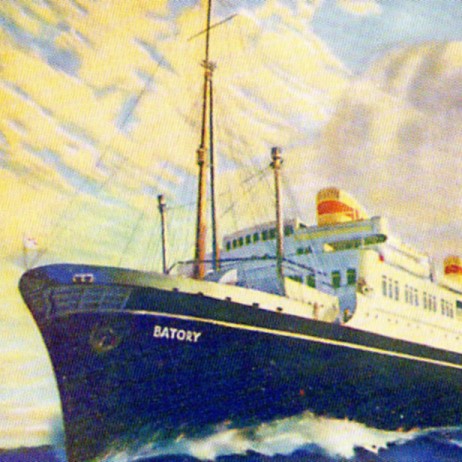
04 Aug Lucky Ship
She sailed for 34 years and was one of the most beautiful, most luxurious ships sailing under polish banner. Discover the story of the Lucky Ship, the pride of Poland’s merchant marine.
It was a beautiful time. Air travel felt like flying in a loud, trembling tin can, and no one in their right mind, save for a handful of daredevils, would even think of crossing the Atlantic in a plane, much less with passengers on board. Intercontinental travel was made possible by ships: big, beautiful, majestic ocean liners. While the crossing from Europe to America took over a week, what a week it was! Transatlantic lines spared no effort in providing the highest level of comfort and luxury to their passengers. The same was true of the legend of Poland’s merchant marine, the transatlantic ocean liner MS Batory, which played an iconic role in the history of Polish emigration to the United States and earned the nickname Lucky Ship, albeit under wartime conditions, and not during regular passenger voyages.
Impressive and sparkling with newness, the 526-foot ocean liner towered several stories over the dock, and boasted seven decks of passenger cabins, dining rooms and ballrooms, a library, three bars, a swimming pool and a gym. She was launched in 1935 and set off on her cross-Atlantic voyage from Gdynia to New York City on May 18, 1936, under the command of Captain Eustazy Borkowski, in the livery of the Gdynia-America Line.
Cpt. Borkowski was quite the adventurer, and remains a semi-legendary figure to this day. He’s the subject of countless anecdotes and stories frequently recounted in Polish maritime circles. It goes without saying that the captain was the life and soul of the party, and was adored by women. He had plenty of quirks, but the truth is that everyone wanted to sail with him. Simply put: a voyage with Captain Borkowski was a guarantee of adventure and good fun. In the Prohibition era, the captain would hold what he called “Moontrips,” or booze cruises under the cover of night. The beautifully decorated ship would quietly slip up the New England coast toward Canada. As soon as the vessel left U.S. territorial waters, the sound of popping champagne corks would echo across the surface of the ocean. Such were the days, and such was the captain. National Geographic even titled him “Captain of the Seven Seas,” and the New York Times called him the most famous and colorful figure to sail the Atlantic between the wars.
And how did the Lucky Ship get its nickname? When World War II broke out in 1939, the decks and cabins of the Batory were stripped of their luxury fixtures, and with them disappeared the joyful laughter of the ship’s passengers. They were replaced with military bunks and machine gun nests. The ship was mobilized by the United Kingdom and served in the war. She spent 600 days at sea, zigzagging among ravenous swarms of U-boats, dodging missiles and torpedoes, taking part in landings in the north, ferrying precious treasures and valuables across the ocean, and carrying out secret missions. She returned to port safely each time, as if something or someone were looking over the ship and providing her with good fortune. Her sister ships, the Piłsudski and the Chrobry, had less luck, and were resting in the cold, dark depths of the sea. As the author of one contemporary news article put it:
“Plenty of water has since flown under the keel of the Batory, but for 480 British children, it will always be a lucky ship.”
The MS Batory sailed under the Polish flag until the 1960s, when she was decommissioned, and ended her illustrious career as a floating hotel. Sadly, she was scrapped somewhere in Asia in the 1970s. Too bad: she’d make a great tourist attraction and a fine landmark today.


